Which battery for the screwdriver is better to choose
The cordless screwdriver is a fairly convenient and sought-after tool. Independence from the power grid makes this device mobile and allows you to work in hard-to-reach places. But despite all the advantages, the rechargeable battery (battery) is the weak link in the screwdriver. Therefore, when choosing a power tool, you first need to understand what types of batteries exist, what is the difference between them, the pros and cons of different types of batteries.
Content
Varieties of batteries for the screwdriver
There are 3 types of batteries on the power tool market:
- (NiCd) nickel cadmium;
- (NiMH) nickel metal hydride;
- (Li-Ion) lithium-ion.
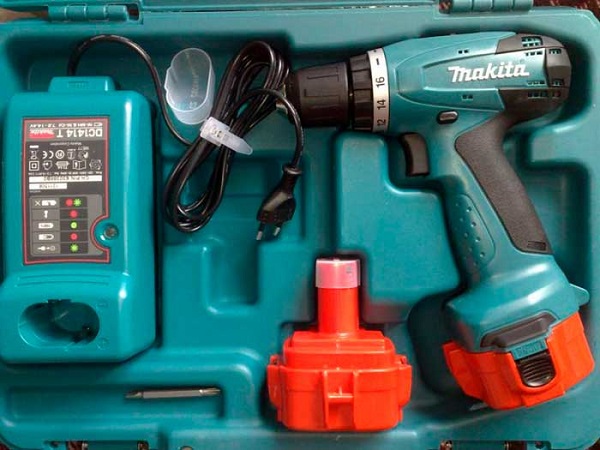
Nickel Cadmium Battery
This type of battery is most common, although they are more than 100 years old. NiCd batteries have good capacity and low cost.
Nickel-cadmium batteries have the following advantages.
- Durability. With proper operation of the battery can serve 8-10 years.
- Work opportunity at low temperatures. The battery charge is almost not reduced, which allows you to use the tool in the winter outdoors.
- High degree of reliability and unpretentiousness to working conditions.
- A battery withstands a thousand charge-discharge cycles.
- The battery can be stored for a long time in a discharged state.
Since NiCd batteries are not “afraid” of a full discharge, you can operate the tool until it stops completely, that is, until the battery is deeply discharged. Only after that you can put it on charge without fear that the battery capacity will decrease.
However, nickel-cadmium batteries are not without drawbacks. Internal toxicity Batteries cause problems when disposing.
In some European countries, the use of nickel-cadmium batteriesprohibited in order to preserve ecology.
Batteries of this type are quite heavy when compared with other types of batteries. In addition, they have a “memory effect”". Such a phenomenon occurs in a nickel-cadmium battery, when it is not allowed to completely discharge. If you turn on such a battery for recharging, then it will “remember” this value and during further work it will discharge to this mark. Thus, a significant part of the battery capacity will be lost. The figure below clearly demonstrates how the “memory effect” appears.
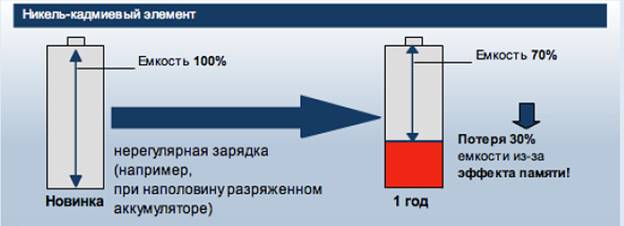
Nickel metal hydride batteries
NiMH batteries have been designed to eliminate the drawbacks of a nickel-cadmium battery. The positive characteristics of nickel-metal hydride batteries are as follows:
- have smaller dimensions and weight;
- have low toxicity;
- “Memory effect” is weak;
- have high capacitive characteristics;
- resistant to mechanical damage;
- increased number of charge-discharge cycles (up to 1500).
However, NiMH batteries have their drawbacks:
- they must not be used at negative ambient temperatures;
- The battery has the ability to quickly discharge;
- shorter battery life when compared with a nickel-cadmium battery;
- high price;
- takes a long time to charge;
- The battery does not "carry" a deep discharge.
Thus, although NiMH batteries were created to compete with a nickel-cadmium battery, they significantly inferior in performance last one.
Lithium ion batteries
Li-Ion batteries noticeably win most positions from other types of batteries. The advantages of lithium-ion batteries include the following:
- almost complete lack of “memory effect”;
- You can recharge the lithium-ion battery at any stage of discharge, without fear of loss of capacity;
- no power loss with low battery charge;
- effective life is 5-8 years;
- low self-discharge;
- it takes a little time to charge;
- no toxic elements;
- high power with small dimensions.
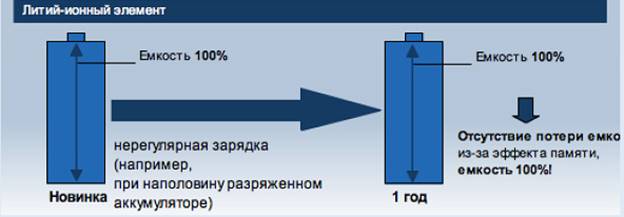
Cons of lithium-ion batteries:
- sensitivity to shocks (may explode with strong shocks);
- the battery does not tolerate a full discharge and overcharge - from this battery fails;
- at low temperatures it discharges quickly;
- high price;
- service life is lower than that of a nickel-cadmium battery.
Definitely say which battery is better is difficult. Mainly, you have to decide for what purposes you are going to purchase a screwdriver. If for home use, which implies an infrequent inclusion with long interruptions in work, then you need to choose a tool with a nickel-cadmium battery.
This can be explained by the fact that during long-term storage without recharging the NiCd battery does not lose its properties, provided that it has been completely discharged.
Lithium-ion batteries are choice of professionals. They are designed for continuous, long-term and continuous work. Also for professional tools, it is important to recharge battery. But it is worth remembering one rule: the lithium battery can not be brought to full discharge.
What can replace the “native” battery in the screwdriver
If the batteries in your screwdriver are exhausted, they can be easily replaced. There is such a thing as battery interchangeability. For example, under brand PowerPlant manufactured by the battery, having compatibility with most popular brands of power tools. They cost much less than “native” batteries and are quite efficient.
But if this option does not suit you, then the batteries themselves in the unit can be replaced with new ones. To do this, it is necessary to disassemble the battery pack and remove the elements contained in it.
Replacing batteries with similar ones
On some blocks, you can see the mounting screws that need to be unscrewed. But on most battery packs there are no self-tapping screws, since the casing is glued together. To open such a unit, you will need to carefully insert a screwdriver into the gluing place (shown in the photo with an arrow) and press lightly to detach the case walls. The same steps need to be done around the perimeter.

After opening the unit, you will see the batteries in it.
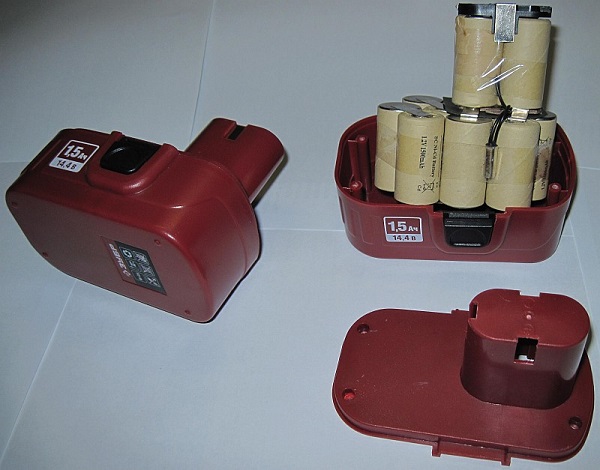
Next, you should look at the label applied to the elements, write it down and select the same ones in the online store. When new batteries are available, they need to be soldered and put back into the case. To solder batteries, you will need a soldering iron and flux (alcohol on rosin or soldering acid), as well as tin. It is necessary to take into account several nuances during soldering.
- You need to solder quickly, not allowing the battery to heat up, as it may become unusable.
- For connections you need use native plates, having unsoldered them from old batteries (they have the necessary section and resistance).
- It is important to properly connect plus to minus battery. The elements must be connected in series: the minus of the previous battery must be connected to the plus of the new one, and the minus of the new battery to the positive terminal of the next battery.
After connecting all the elements, it is necessary to equalize the potentials on all batteries, since they differ. Spend one charge-discharge cycle: connect the charger to the battery for the night, then let it cool for 24 hours and measure the output voltage in turn on all elements. If everything went well, then on all batteries the indicator will be the same - within 1.3 V.
Now the battery must be discharged by inserting it into the screwdriver and loading the latter to the maximum. The main thing is not to overheat the engine tool. Give him a little rest. Bring the battery to full discharge. This procedure should be repeated 2 more times (full charge and full charge).
Replacement for lithium batteries
Replacing NiCd elements with Li-Ion is also not difficult.It is known from the school course that if the batteries are connected in series, their voltage ratings will be summed up. For example, your screwdriver is powered by a battery with a voltage of 14.4 V, which means that it can be replaced with four 3.3 V batteries. This voltage will be enough, because the lithium batteries do not sag too much when the device is started.

It is recommended to buy batteries from well-known manufacturers, for example, Sistem A123. Battery LiFePO4 of this company has a capacity of 2400 mAh, sufficient for the normal functioning of the screwdriver. If you buy batteries through the Internet, then they will cost you less - around 900 rubles for 3 pieces.
When buying batteries, pay attention to whether there are copper strips on their contacts. If they are, the soldering process is much easier.
Also need to purchase instead of alcohol flux soldering acid. In this case, overheating of the batteries will be minimized. The soldering iron must have a power of 65 watts.
You can learn more about how batteries are replaced with lithium batteries by looking at it. video.
Charger for the battery DIY screwdriver
If your charging for the screwdriver is out of order, or you have altered the instrument's battery by replacing the NiCd batteries with Li-Ion cells, then you will need to get a new charger. Below is a diagram of a charger capable of providing a charging current suitable for any type of battery.

This charger is a current generator, which is based on the transistor VT2. The latter receives power from the rectifier bridge. The bridge, in turn, is connected to step down transformerhaving the required output voltage. This transformer must have good power so that it can work for a long time without overheating, providing the necessary current. Otherwise, the transformer may burn out. The voltage supplied by the transformer must not be higher than 27 V.
The charge current is regulated by a resistor R1 (the battery for the screwdriver must be connected). It must remain constant throughout the charging process. Resistor R3 is designed to limit the maximum current. LED VD6 will burn as long as the charge goes on.When the charging process comes to an end, the LED light will start to decrease, and it will go out.
For lithium-ion batteries, temperature control and accurate voltage values are important.
All elements of the electronic circuit are installed on PCB PCBcovered with a layer of copper foil. The diodes indicated in the circuit can be replaced with diodes extracted from old radio equipment, KD202 or D242. Details on the board must be placed in such a way that there are no intersections. High density placement of parts is not needed. If you leave 3-5 mm between them, then it will be easier to solder. Be sure to install the transistor on a radiator with an area of at least 20-50 cm2.
Based on the size of the board, you will need make a case (can be made of plastic) using an adhesive gun. The table below provides the entire list of required radio components.
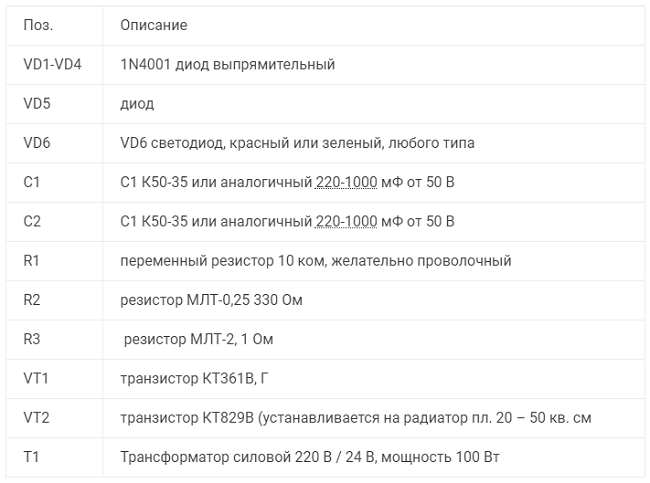
If you assemble the charger by following this scheme, you will get reliable, simple and inexpensive charging for your screwdriver.

/rating_off.png)











